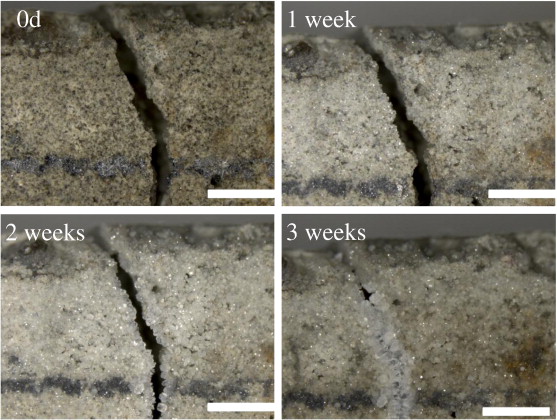 Smart materials can help build longer- lasting infrastructure with potentially large savings for cities and nations. Self-healing bio-concrete (or self-healing concrete), was invented by Henk Jonkers, a microbiologist and professor at Delft University of Technology in the Netherlands. Jonkers began developing self-healing concrete in 2006. After three years of experimenting, he found the perfect healing agent - bacillus.
Smart materials can help build longer- lasting infrastructure with potentially large savings for cities and nations. Self-healing bio-concrete (or self-healing concrete), was invented by Henk Jonkers, a microbiologist and professor at Delft University of Technology in the Netherlands. Jonkers began developing self-healing concrete in 2006. After three years of experimenting, he found the perfect healing agent - bacillus.
Admixtures are chemicals added to the mix to achieve special purposes, such as increasing workability at the same water content, changing the setting time, or compensating for the shrinkage of concrete when it hardens. They can also increase strength, improve resistance to freeze-thaw damage, reduce permeability and inhibit corrosion of steel reinforcement.
For example, retarders can temporarily prevent hydration from taking place by slowing the reaction and allowing the concrete to be workable during the placing process. To help infrastructure resist freeze-thaw damage, “air entraining” admixtures are commonly used to stabilize air bubbles created during mixing. This provides space for water to expand and contract, increases the resistance of concrete to freeze-thaw damage and avoids premature cracking.
CONCRETE CRACKS
While concrete can handle significant compressive loads, its tensile and flexural load carrying capacity is limited. Application of tensile loads, expansion and contraction, freeze-thaw damage or deterioration of the steel reinforcement can cause concrete to crack. Cracks can appear because of the shrinkage experienced when water not used for hydration gradually evaporates from the hardened mix. Concrete can also undergo volume changes due to thermal effects, and this expansion and contraction can lead to cracks.
Freeze-and-thaw cycles leave cracks in concrete roads, and when salt is spread to defer ice formation, it enters the concrete and damages the steel reinforcement. Some cold-climate cities are beginning to use sand instead of salt to avoid this problem. Cracks can result in problems such as water leakage, frost damage and reinforcement corrosion. Repairing concrete, in addition to being costly, causes significant
inconvenience to residents. Construction-related traffic congestion affects people’s everyday lives.
So, this begs the question as to whether construction managers and facility managers should seek and use longer-lasting alternatives to traditional concrete.
SELF-HEALING BIO-CONCRETE
Traditional concrete has always been produced with inert materials. However, “self-healing bio-concrete” changes this paradigm. Inspired by biology, this concrete is made of “living materials” and can heal itself, like trees or human skin. It can autonomously repair itself after crack formation, with no or limited human intervention, and that can dramatically reduce maintenance and repair costs. This product is a sustainable solution that improves the lifespan of buildings, bridges and roads.
HOW DOES SELF-HEALING WORK?
Self-healing concrete introduces a healing agent into the concrete mixture as another type of aggregate. The healing agent consists of three components: the active organism (bacteria or fungi) that acts as a
catalyst, a mineral that acts as “food” for the organism and capsules that are containers. The capsules need to survive the mixing and casting of the concrete and should remain intact until the organisms’ action is needed to close the cracks. Spores of limestone-producing bacteria like /Bacillus pseudofirmus/, which are alkali-resistant, are well adapted for concrete applications. They produce endospores with low metabolic activity, are able to resist high mechanically and chemically induced
stresses and can remain dormant for up to 200 years inside the concrete.
When concrete cracks and water and air reach the capsules, the environmental conditions are favorable for the spores to germinate and grow into active bacterial cells. The bacteria then feed on the calcium lactate and form limestone, sealing the cracks. This healing happens in just three weeks. Calcium lactate is “food” for the bacteria and does not affect the material properties when mixed in the concrete. Biodegradable plastic is used for the capsules as it has to be strong enough to survive the mixing phase while bonding well with the surrounding hydrated cement paste. It is also able to break when cracks
form to release the bacteria and nutrients. In addition, the capsules need to be inert to the chemicals and additives in concrete and to the healing material they are carrying. This has been achieved by the immobilization of the bacterial spores and the calcium lactate in expanded biodegradable plastic particles. They represent a structural element of the concrete and a protective matrix for the self-healing agent.
Apart from cracks, there is another important surface flaw in concrete called “scaling degradation,” which results in “spalling.” This appears during freeze/thaw cycles in the presence of de-icing salts. Test results showed 50 percent less scaling with the self-healing concrete compared to untreated samples. Like concrete, self-healing bio-concrete is non-flammable and non-explosive. By making concrete more long-lasting, the need for cement is reduced.
BIO-CONCRETE CHALLENGES
It is difficult to change the mindset of contractors who have worked for years with regular concrete. It might be hard to convince companies to invest in self-healing bio-concrete as they might anticipate more expenses for material, installation and maintenance. However, self-healing materials can be added as another aggregate in the concrete mix. Companies can proceed as if it were traditional concrete.
Self-healing bio-concrete currently has a production cost that is almost twice that of regular concrete. This is driven by the calcium lactate nutrient for the bacteria (European Patent Office). Active research is underway to develop alternative nutrients that would reduce the cost to a level closer to regular concrete, between US$150 and US$180 per cubic yard. However, concrete often accounts for only a small percent of the total cost of construction projects. The higher initial cost of self-healing materials can be recovered in three to four years.